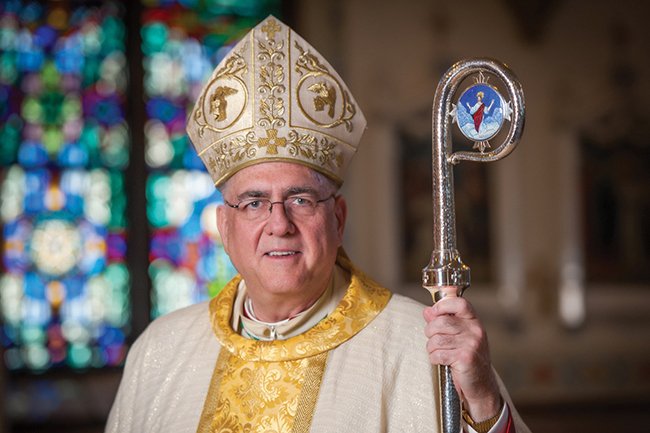by Archbishop Joseph F. Naumann
During my homily at our recent Archdiocesan Convocation of Parish Ministries, I offered my top 10 reasons why I love being Catholic. Frankly, it was difficult to narrow the list to 10. The following are my 10 through six choices.
- 2,000 year history: The famous English 19th-century convert to Catholicism, Cardinal John Henry Newman, said: “To be deep in history is to cease to be Protestant.” Conversely, to know history is to be Catholic. Many former Protestants have read themselves into the Catholic Church by studying the writings of the early Fathers of the Church.
- Biblical church: The Bible is both the fruit of the Catholic Church and its guide. Sadly, many Christians who proclaim that the basis of their faith is “sola scriptura” — “the Bible alone” — have no idea of the origins of the Bible.
Jesus did not hand his first disciples a copy of the Gospels or the entire New Testament. The Gospels were the written memoirs of the early church regarding the ministry, teaching and, most importantly, the meaning of the life, death and resurrection of Jesus Christ.
The New Testament, as we know it today, was not codified and ratified by the church (synods and councils of bishops) until the fourth century. As Catholics, we believe that the Holy Spirit inspired the authors of the biblical books, as well as the church’s bishops in determining which of the early Christian writings to include in the Bible.
For a large part of Christian history, the personal reading of the Bible was inaccessible to most believers because they were illiterate. If pondering the biblical text is necessary for knowing and encountering Jesus, how is it possible that for at least three-fourths of Christian history, the vast majority of Christians had no opportunity to read the Scriptures?
Jesus did not give his disciples copies of the New Testament. Instead, Jesus gave his apostles the authority to communicate faithfully his teaching, part of which made it possible for their successors, the pope and bishops, to compile the New Testament.
The Mass from the earliest times has included the oral proclamation of what became the New Testament. The Bible came out of the church and it is revered by Catholics as God’s written revelation. As Catholics, we pray over most of the New Testament and a good sampling of the Old Testament during the three-year liturgical cycle.
- Rich and diverse spirituality: The Catholic Church offers a wide variety of options for developing and enriching our prayer life. The Catholic Church includes many methods and approaches to prayer, e.g., contemplative, meditative, charismatic etc.
Many of the religious orders within the church developed their own unique spirituality, e.g., Ignatian (Jesuits), Carmelite (based on the writings of St. John of the Cross, St. Teresa of Avila, St. Thérèse of Lisieux, etc.), Benedictine, Dominican and Franciscan. The Catholic Church offers a rich diversity of devotional practices, e.g., eucharistic adoration, the rosary, novenas, pilgrimages, lectio divina (the prayerful reading of the Bible), etc.
- Church of beauty: Catholics have expressed our faith through beautiful art (paintings, frescoes and mosaics), incredible music and magnificent architecture. The church has used art both to catechize and inspire.
You do not have to go to Europe to visit magnificent churches that are examples of amazing Catholic architecture and art. It is impossible not to be inspired by visiting and, more importantly, praying in churches such as: the Basilica of the National Shrine of the Immaculate Conception in Washington, D.C.; St. Patrick’s Cathedral in New York; the Cathedral Basilica in St. Louis; the San Francisco cathedral; Conception Abbey Church in Conception, Missouri; St. Mary Church in St. Benedict (one of the eight architectural wonders of Kansas), etc.
Michelangelo, Caravaggio and Raphael are a few of the more well-known Catholic Renaissance artists. Currently, our own archdiocesan pastoral center is hosting an exhibition of incredible religious art created by contemporary Catholic artists.
- Church of joy: Catholics are always celebrating. In addition to the great feasts of Christmas and Easter that take an entire season (weeks) to celebrate properly, our liturgical calendar throughout the year observes the feasts of remarkable Catholic heroes, whom we call saints.
For two millennia now, Catholics always have celebrated festivals. All of the parishes in the archdiocese carry on this beautiful tradition with parish picnics and dinners that always feature great food and fun. The church in our country has been one of the largest sponsors of youth athletics. Historically, Catholic parishes have often had drama clubs. It is fun to be Catholic.
Stay tuned next week for my top five choices for the reasons I love being Catholic!


